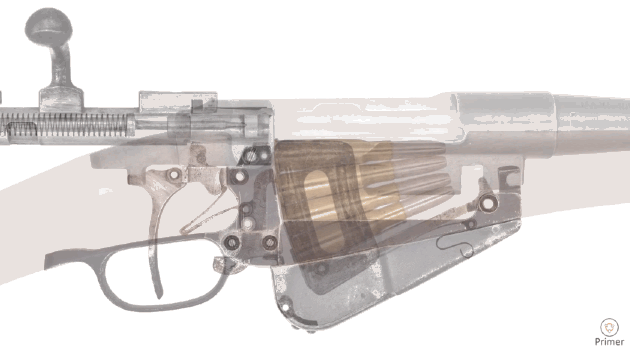Setting optimum headspace on your rifle brass can be a confusing chore. But if I can do it, so can you.
Let’s start with the basics.
When I pull the trigger of a firearm, its firing pin strikes the cartridge primer, igniting it, which in turn sets off the powder charge.

The resulting rapid expansion of gases (“explosion” to you and me) propels the bullet down the barrel and on its way.
Meanwhile the brass cartridge case, unable to contain the sudden increase in pressure (on the order of 50,000 psi), expands like a balloon.
If everything is sized correctly, it doesn’t expand very far before it reaches the walls of the gun’s chamber. The brass does “spring back” slightly after that initial surge, but remains larger than it was before firing.
This is why hand loaders “resize” brass: otherwise, it would be a tight squeeze in the chamber next time–and might not fit at all in someone else’s rifle.
Chamber dimensions are decreed by the Sporting Arms and Ammunition Manufacturers’ Institute (SAAMI). The idea is that by complying with SAAMI standards, ammunition manufacturers can be sure that their cartridges will fit into any compliant chamber.
However, there are tolerances, and they can stack. The better your cartridges fit your specific chamber, the more consistently accurate you can expect them to be.
Therefore some reloaders only size the necks of their fired brass back down (to hold the new bullet). They don’t resize the body, since it’s already been “fire formed” to fit their rifle’s chamber.
We more casual shooters generally use “full size” dies to squash the whole case back to standard size, so that it’ll fit in a dirty chamber, etc.
You can measure this by using a “case gauge” for the chamber you’re reloading. If the brass fits into the case gauge, it’ll fit into a standard chamber.
Headspace: what is it and why do I care?
One critically important case dimension is “headspace,” or the clearance left between the base, or “head,”* of a fully inserted case and the bolt face.
*just to keep everyone confused, the bottom of a case is called the “head,” while the other end–the end the bullet goes into–is the “mouth”

Per SAAMI standards, for bottle-necked cartridges headspace is referenced by measuring the distance from the head of the case to the point, or “datum,” on the case shoulder that contacts the rifle’s chamber and prevents it from going any deeper into the chamber.

Headspace is important because if it’s wrong, bad things can happen: not enough headspace and the cartridge won’t fit in the chamber; too much, and the unsupported brass can stretch excessively or even rupture (!) when fired.
If headspace is only a little tight, it may just be hard to close the bolt (because you’re compressing the brass). If there’s only a little extra, the round could be loose enough in the chamber to affect accuracy (because it doesn’t seat consistently from shot to shot).
Using a sizing die to move the shoulder of an expanded, fired case back to achieve optimum headspace is referred to as “shoulder bump.”
You can check for adequate headspace by measuring your sized brass with a case gauge.

This guarantees that your cartridge headspace meets standards and is safe.
For my pistols, that’s good enough. However, I tweak rifle ammunition headspace still further to improve accuracy over long distances.
Adjusting headspace for consistency & accuracy
Once you know the size of your rifle’s chamber, the goal is to bump the shoulder of your fired cases .001 to .002″ (one to two thousandths of an inch) back from that.
For repeating rifles like lever-action or semi-autos, I bump the shoulders back .003 to .004″ to allow a little extra clearance for mechanical feeding.
Figuring out your rifle’s chamber size isn’t difficult: just measure your fired brass.
The tool I use for this is a Hornady headspace comparator (they come in a set).
(note: some of these are affiliate links. This means if you click the link and buy the related product, the vendor may pay me a fee. Your cost is not affected)
Choose the comparator that matches your case, attach it to your calipers, then measure several fired cases. Find the average value.

The average headspace reference measurement for these fired 6mm ARC cases was 1.1925″. Since this is a gas gun, I wanted between .003 and .004″ of shoulder bump back from that.
However, after running the brass through my resizing die, the headspace reference averaged 1.1901″. This meant I was only bumping the shoulder back .0024″.

I loosened the locking ring on my sizing die and screwed the die down a little until I saw .0035″ of shoulder bump, then locked the ring back down to hold it there.

I get pretty good results doing this with once-fired brass, but it may take several firings for your brass to fully expand to fit your rifle’s chamber.
In the meantime you can just “neck size” the brass (I use a Lee collet die) for the first few cycles, then measure it with your comparator and adjust your full size die to get the shoulder bump you want.
Unless your sizing die works itself loose or you mount it in a different press, you don’t need to do this again as long as you’re loading for the same gun (specifically, for the same chamber in the same barrel of the same gun).
Having adjusted my sizing die for my specific chamber, I still spot check the brass in a case gauge to make sure headspace isn’t completely out of whack.

And that’s all there is to it.